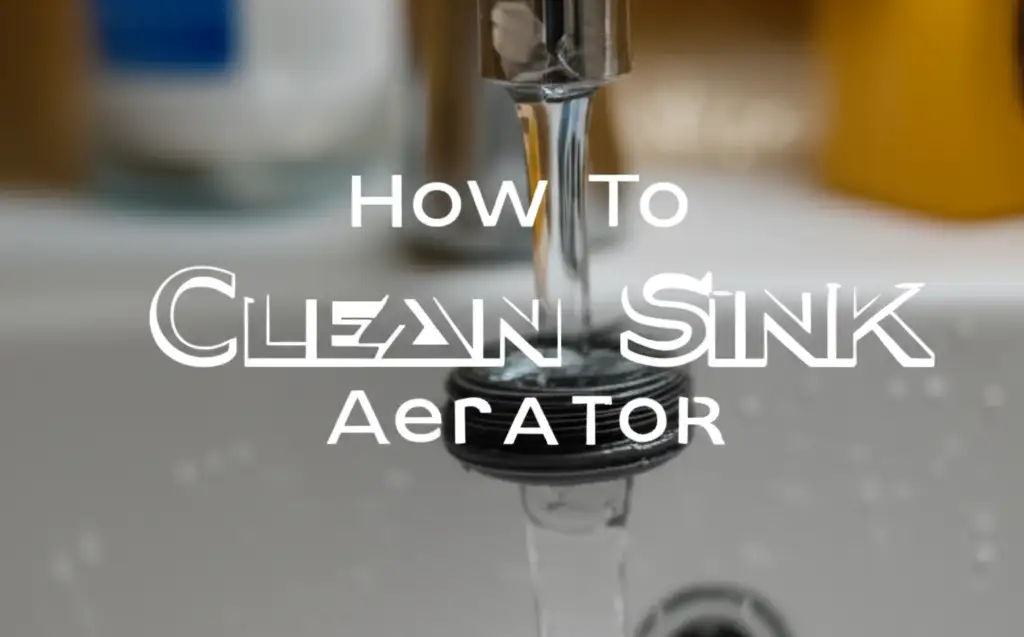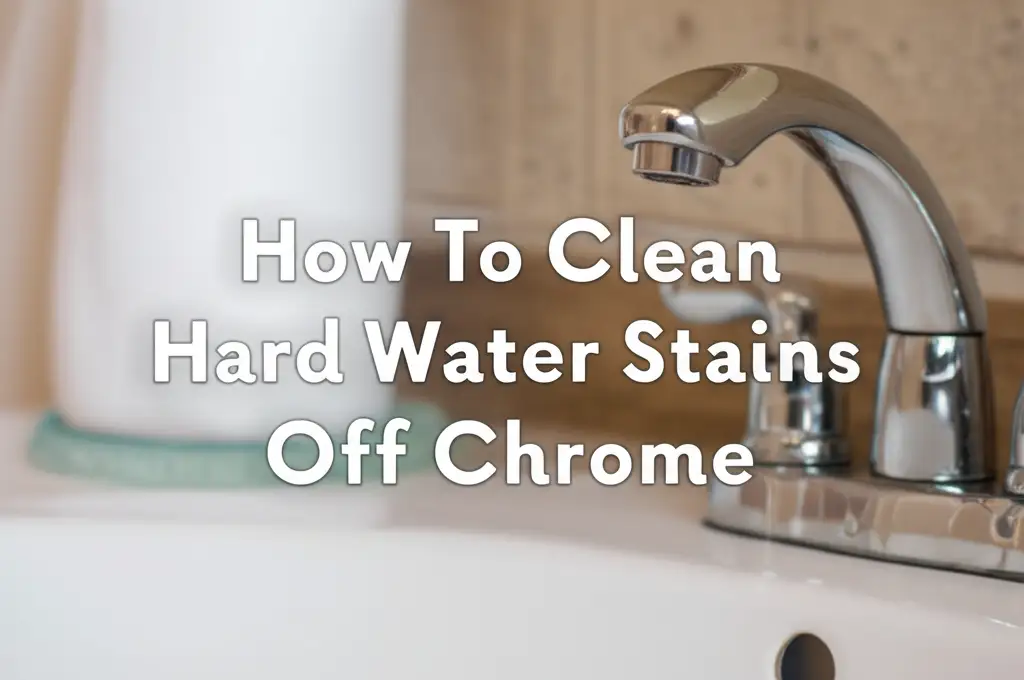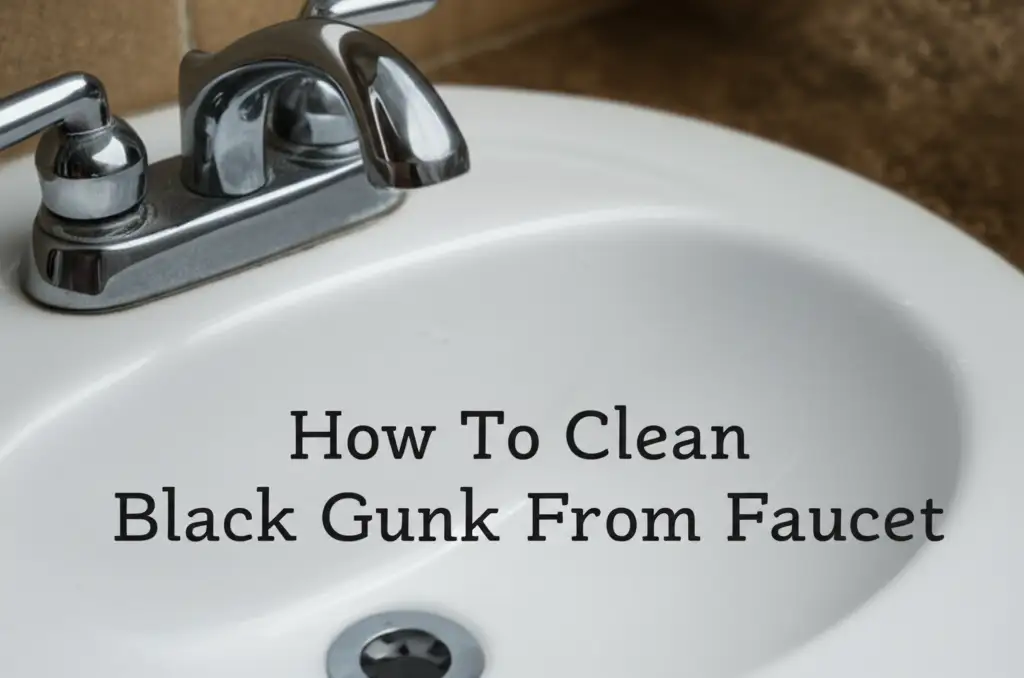· Home Cleaning · 19 min read
How To Clean Sink Aerator

Restore Your Flow: How to Clean a Sink Aerator
Have you noticed your kitchen or bathroom sink faucet spraying erratically? Maybe the water flow has slowed to a trickle. These common issues often point to one small, often overlooked component: the sink aerator. This tiny screen at the end of your faucet plays a big role in your water quality and pressure. I’ve seen countless times how a clogged aerator can frustrate daily tasks.
Cleaning your sink aerator regularly helps maintain good water pressure. It also ensures you get clean, aerated water for washing hands or dishes. I am here to guide you through the process. We will cover identifying issues, gathering tools, and effective cleaning methods. This article will help you restore full water flow. You will also learn how to keep your aerator spotless for the future.
Takeaway:
- Address low water pressure or erratic spray by cleaning your sink aerator.
- Gather simple tools like a wrench, cloth, and vinegar before starting.
- Always turn off the water supply before removing the aerator.
- Soak the aerator in vinegar to dissolve mineral buildup effectively.
- Regular cleaning prevents future clogs and maintains water quality.
How do you clean a sink aerator?
You clean a sink aerator by first unscrewing it from the faucet spout. Then, you disassemble its small parts, if possible. Next, you soak these parts in white vinegar for several hours. This dissolves mineral deposits. Finally, you scrub any remaining debris, rinse thoroughly, and reassemble the aerator.
Understanding Your Sink Aerator and Why It Needs Cleaning
The sink aerator is a small, mesh screen device located at the very tip of your faucet spout. It mixes air into the water stream as it exits the faucet. This aeration creates a consistent, splash-free flow. It also conserves water without reducing the sensation of water pressure. This small part makes a big difference in how your faucet performs. I often explain this to people dealing with sputtering water.
Over time, these aerators collect various deposits. Hard water is a major culprit. It leaves behind mineral buildup, like calcium and lime, which restricts water flow. Rust particles from old pipes can also accumulate. Debris from the water supply, such as small sediment, also gets trapped. These blockages cause problems like low water pressure, uneven spray patterns, or even complete blockages. If you have ever seen water spraying in odd directions, a dirty aerator is likely the cause. Maintaining a clean aerator ensures smooth, clear water delivery for everyday use.
Signs Your Sink Aerator Needs Attention
Recognizing when your aerator needs cleaning saves you from bigger plumbing headaches. Here are some clear indicators I look for:
- Weak Water Pressure: The most common sign. If your faucet used to have strong flow but now it is weak, the aerator is probably clogged.
- Erratic or Splashing Water: Water spraying sideways or in multiple directions means some holes in the aerator screen are blocked. The remaining clear holes shoot water out unpredictably.
- Dirty Water or Debris: If you see small particles or discolored water coming from the faucet, the aerator might be holding onto debris. This debris can even cause an unpleasant smell.
- Unusual Noises: A whistling or sputtering sound from the faucet when the water runs suggests air is struggling to pass through a restricted aerator.
- Visible Buildup: Sometimes, you can simply look at the end of your faucet. You might see white, crusty mineral deposits or green discoloration around the aerator.
Addressing these signs early prevents further buildup. It also helps avoid potential damage to other faucet components. A simple cleaning can restore your faucet’s performance quickly.
Essential Tools and Materials for Aerator Cleaning
Before you start cleaning your sink aerator, gather all the necessary tools and materials. Having everything ready makes the process smoother and faster. I always recommend laying everything out on a clean towel. This prevents losing small parts and protects your countertop. You might already have most of these items around your home.
Tools You Will Need
- Adjustable Wrench or Pliers: These are for unscrewing the aerator if it is too tight to turn by hand. Always wrap the aerator with a cloth before using these tools. This prevents scratching the finish.
- Small Bucket or Bowl: This is for soaking the aerator parts.
- Old Toothbrush or Small Scrub Brush: Perfect for scrubbing away stubborn deposits without damaging the mesh.
- Paper Towels or Soft Cloths: For drying parts and cleaning up spills.
- Small Container (Optional): Helpful for keeping very small parts together if your aerator disassembles into many pieces.
- Flashlight (Optional): Useful for seeing inside the faucet spout to check for any remaining debris after removal.
Cleaning Solutions and Materials
- White Vinegar: This is your main cleaning agent. Its acidic nature effectively dissolves mineral deposits like calcium and lime. I always keep a large bottle of white vinegar on hand for various cleaning tasks, not just aerators. You can also use it to clean your sink drain with vinegar.
- Warm Water: For rinsing and, sometimes, for mixing with vinegar.
- Dish Soap (Optional): A few drops can help clean away grime and grease before soaking in vinegar.
- Small Safety Pin or Toothpick (Optional): For poking out stubborn bits of debris from the aerator screen holes. Use with care to avoid damage.
- Rubber Gloves (Optional): To protect your hands from cleaning solutions.
Having these items prepared will ensure you can tackle the cleaning job efficiently. You will be ready for any type of buildup you encounter.
Step-by-Step Guide: How to Remove Your Sink Aerator
Removing the sink aerator is the first crucial step in cleaning it. The process is generally straightforward, but slight variations exist depending on your faucet type. Always be gentle to avoid damaging the faucet or the aerator itself. I usually start by putting a stopper in the sink drain. This prevents any small parts from falling down the drain.
Preparation Before Removal
- Turn Off the Water Supply: While not strictly necessary for aerator removal, it is a good safety measure, especially if you expect to do more than just clean the aerator. It also prevents accidental water sprays while you are working.
- Clear the Area: Remove any dishes, sponges, or other items from the sink basin. This gives you plenty of room to work.
- Protect Your Sink: Place a soft cloth or towel in the bottom of your sink. This protects the sink finish if you drop a tool or aerator part. It also cushions the aerator if it slips.
Removing the Aerator
Identify Your Aerator Type:
- External Aerator: This type screws onto the outside of the faucet spout. It is visible and easily accessible.
- Internal Aerator: This type is recessed inside the faucet spout. It often requires a special aerator key or tool for removal.
- Hidden Aerator: Some modern faucets have a nearly invisible aerator. It requires a specific tool that usually comes with the faucet. For these, refer to your faucet’s manual.
Attempt Hand Removal: Many aerators can be unscrewed by hand. Grip the aerator firmly and turn it counter-clockwise. If it turns easily, great!
Use Tools if Needed: If the aerator is too tight or stuck due to mineral buildup, you will need a wrench or pliers.
- For External Aerators: Wrap a cloth around the aerator. This protects the finish. Then, use an adjustable wrench or pliers to gently grip the aerator. Turn it counter-clockwise until it loosens.
- For Internal/Hidden Aerators: If your faucet came with a special plastic aerator key, insert it into the slots on the aerator and turn counter-clockwise. If you don’t have the key, sometimes universal aerator keys can be purchased. For Delta faucets, specific tools or methods might be needed, and you can find guidance on how to clean Delta faucet aerator for detailed steps.
Carefully Detach and Disassemble: Once loose, fully unscrew the aerator. It usually comes off as a single unit or separates into several small parts. These parts might include a rubber washer, metal housing, a flow restrictor, and the mesh screen. Pay attention to the order of these parts as you remove them. This makes reassembly easier. I often take a quick photo with my phone as I disassemble it. This provides a visual guide later.
Once the aerator is off, you are ready for the cleaning stage. Remember, patience is key, especially if your aerator is stubborn due to heavy buildup.
Effective Cleaning Methods for Your Sink Aerator
Now that you have successfully removed your sink aerator, it is time for the cleaning process. This is where you tackle the mineral buildup and debris that have been hindering your water flow. I primarily rely on white vinegar for its effectiveness.
The Vinegar Soak Method (Most Common and Effective)
This method is highly effective for dissolving mineral deposits. It is my go-to solution for almost all aerator clogs.
- Disassemble the Aerator: Carefully separate all the small components of the aerator. This usually includes the mesh screen, the flow restrictor, the rubber gasket, and the metal housing. Lay them out in order on a paper towel.
- Initial Rinse: Rinse each part under warm running water. Use an old toothbrush to gently scrub away any loose debris, grime, or visible particles. This removes surface dirt before the deep cleaning.
- Prepare the Soaking Solution: Fill a small bowl or cup with undiluted white vinegar. Ensure there is enough vinegar to fully submerge all the aerator parts.
- Soak the Parts: Place all the aerator components into the bowl of vinegar.
- Soaking Time: Allow the parts to soak for at least 2-4 hours. For heavy mineral buildup, I often let them soak overnight (6-8 hours). The acid in the vinegar will break down calcium, lime, and rust deposits.
- Scrub After Soaking: After soaking, remove the parts from the vinegar. Use an old toothbrush or a small scrub brush to thoroughly scrub each component. Pay special attention to the mesh screen. For stubborn bits lodged in the tiny holes, gently use a small safety pin or a toothpick to poke them out. Be careful not to damage the mesh.
- Rinse Thoroughly: Rinse all components under clean running water. Make sure all vinegar and dislodged debris are washed away. You want the parts to be completely clean and free of residue.
Dealing with Stubborn Clogs and Extreme Deposits
Sometimes, vinegar alone is not enough for extremely heavy buildup.
- Vinegar and Baking Soda Paste: For very tough spots on the outside of the aerator housing, create a paste with baking soda and a little water. Apply it to the stubborn areas and let it sit for 15-30 minutes before scrubbing.
- Boiling Water (Use Caution): For very hard mineral crusts, you can briefly boil the metal parts of the aerator (excluding plastic or rubber components). This can help loosen deposits, but ensure you handle hot parts safely. Follow with a vinegar soak.
- Professional Descaling Solutions: As a last resort, if vinegar does not work, commercial descaling products are available. Always read the instructions carefully and wear appropriate protective gear. These products are stronger and can sometimes damage finishes if misused.
Cleaning Without Removing the Aerator (Quick Fix)
In some cases, you might want a quick clean without removing the aerator. This is often less thorough but can provide temporary relief. You can find detailed steps on how to clean faucet aerator without removing.
- Attach a Vinegar Bag: Fill a small plastic baggie with white vinegar.
- Secure to Faucet: Place the baggie over the faucet spout, ensuring the aerator is fully submerged in the vinegar. Secure it with a rubber band or string.
- Soak: Leave it to soak for a few hours, or overnight for heavy buildup.
- Rinse: Remove the bag and run the hot water for a few minutes to flush out loosened deposits.
While useful, I find that fully removing and disassembling the aerator provides the most comprehensive and lasting clean.
Reassembly and Testing Your Clean Aerator
After thoroughly cleaning all the components of your sink aerator, it is time to put everything back together. Reassembly is often simpler than removal if you paid attention to the order of parts. Remember the picture you took earlier? Now is the time to refer to it. Proper reassembly ensures your faucet functions correctly and prevents leaks.
Steps for Reassembly
- Ensure All Parts Are Dry: Before reassembly, make sure all aerator components are completely dry. Use a clean cloth or paper towel.
- Reassemble Components:
- Carefully place the smaller components back into the main aerator housing.
- The typical order is usually the flow restrictor, then the mesh screen, followed by any washers or gaskets.
- Pay close attention to the orientation of each part. Some washers or screens have a specific side that faces up or down. If in doubt, refer to your earlier photo or faucet manual.
- Ensure the rubber gasket (O-ring) is properly seated in its groove. This gasket creates a watertight seal and prevents leaks. A damaged or missing gasket will cause leaks.
- Screw the Aerator Back On:
- Align the reassembled aerator with the threads on the faucet spout.
- Gently turn the aerator clockwise by hand. It should screw on smoothly without resistance. If it feels stiff or misaligned, stop and re-align it. Do not force it. Cross-threading can damage both the aerator and the faucet.
- Once it is hand-tight, give it a very slight turn with your wrench or pliers. Remember to use a cloth to protect the finish. Do not overtighten! Overtightening can strip the threads or crack the aerator housing. It can also compress the gasket too much, leading to leaks or damage. A snug fit is enough.
Testing for Proper Function and Leaks
Once the aerator is back in place, it is time to test it.
- Turn On Water Supply: Slowly turn the main water supply valve back on. If you turned it off, turn it on completely.
- Check for Leaks: Watch closely around the aerator and the base of the faucet. Look for any drips or sprays.
- If you see a leak, turn off the water, tighten the aerator a little more (but do not overtighten), or re-check the gasket’s seating. Sometimes, simply re-seating the gasket can fix a small leak.
- Test Water Flow and Pressure: Turn on your faucet. Observe the water stream.
- Is the flow strong and steady? It should be.
- Is the spray even and aerated? There should be no erratic spraying or sputtering.
- Are there any unusual noises? A properly cleaned and reassembled aerator should operate quietly.
If the water flow is still weak, or you have persistent leaks, the gasket might be worn out. You might need a new aerator or a replacement gasket. Replacement aerators are inexpensive and widely available at hardware stores. This entire process typically restores your faucet to its full potential, providing a strong, clear, and splash-free water stream.
Preventive Measures and Regular Maintenance
Cleaning your sink aerator brings immediate relief. However, proactive measures can keep it clean longer and prevent future issues. Regular maintenance saves you time and effort in the long run. I always advise my clients on how to keep their fixtures in top shape. These tips apply to all types of sinks, from your regular kitchen sink to cleaning a farmhouse sink.
Schedule Regular Cleanings
- Frequency: The ideal cleaning frequency depends on your water quality. If you have hard water, I recommend cleaning your aerator every 3-6 months. For softer water areas, once a year might be sufficient.
- Easy Reminder: Add it to your seasonal cleaning checklist. For instance, I clean mine every spring and fall. This ensures it doesn’t become a big task.
Address Hard Water Issues
- Vinegar Rinse: Even between full cleanings, periodically wipe the outside of your faucet spout and aerator with a cloth dampened with white vinegar. This helps dissolve minor mineral buildup before it hardens.
- Water Softener: If you live in an area with very hard water, consider installing a whole-house water softener. This system removes minerals from your water supply before it reaches your faucets. It not only protects your aerators but also other appliances. It also helps with general household cleaning, like cleaning your stainless steel sink.
- Under-Sink Water Filter: While a water filter does not reduce mineral hardness, it can trap sediment and other particles that might otherwise clog your aerator. Learn more about cleaning under-sink water filters for comprehensive water quality management.
Avoid Harsh Cleaners
- Stick to Vinegar: Harsh chemical cleaners can damage the finish of your faucet or the plastic components of the aerator. White vinegar is usually all you need. It is natural and effective.
- Gentle Brushes: Always use soft brushes like an old toothbrush. Avoid wire brushes or abrasive pads that can scratch or deform the delicate mesh screen.
Check Other Faucet Components
- Faucet Base: While you are cleaning the aerator, take a moment to wipe down the rest of your faucet. Hard water stains and grime can accumulate around the base. This also helps with the general cleanliness of your sink faucet.
- Hoses and Connections: Occasionally check under your sink for any leaks or signs of wear on the water supply lines. Addressing these early prevents bigger problems. You might notice issues like mold under the sink if leaks are present.
By integrating these simple preventive measures into your routine, you will significantly extend the life and efficiency of your sink aerator. This reduces the frequency of major cleaning interventions.
Troubleshooting Common Aerator Issues
Even after cleaning your sink aerator, you might still encounter some issues. These problems can be frustrating, but many have simple solutions. I often find that a little extra troubleshooting can solve most lingering issues. Do not give up if your faucet is not perfect right away.
Persistent Low Water Pressure
- Check for Remaining Debris: Even after a good soak, tiny particles can remain lodged in the mesh screen. Hold the aerator up to a light source. Carefully inspect each hole. Use a safety pin or toothpick to dislodge any stubborn bits.
- Inspect Internal Faucet Components: Sometimes, the problem is not just the aerator. Debris can also get trapped further up in the faucet spout. With the aerator removed, briefly turn on the water. Let it run into a bucket for a few seconds. This can flush out any larger particles from inside the faucet body.
- Inspect Shut-Off Valves: Check the hot and cold water shut-off valves under your sink. Ensure they are fully open. Sometimes, they might have been accidentally partially closed.
- Whole-House Water Pressure: If all faucets in your home have low pressure, the issue is likely with your main water supply or pressure regulator. You might need to contact a plumber for this.
Leaks After Reassembly
- Gasket Placement: The most common cause of leaks. Ensure the rubber gasket (O-ring) is properly seated and not pinched or twisted. Remove the aerator, reposition the gasket, and re-tighten.
- Damaged Gasket: If the gasket is cracked, stiff, or visibly damaged, it cannot create a good seal. You will need to replace it. Most hardware stores sell universal aerator gasket kits.
- Overtightening/Undertightening: Both can cause leaks. If it is overtightened, loosen it slightly. If it is too loose, tighten it a bit more, always by hand first, then with a cloth-wrapped wrench for a gentle final snug.
- Cross-Threading: If the aerator screwed on crookedly, the threads might be damaged. This can cause persistent leaks. You might need a new aerator or, in rare cases, a new faucet.
Water Still Sputters or Sprays Unevenly
- Incomplete Cleaning: Re-examine the mesh screen. Even one or two blocked holes can cause an uneven spray. Repeat the vinegar soak and thorough scrubbing process.
- Damaged Screen: If the mesh screen itself is bent, torn, or has holes enlarged, it will not properly aerate the water. In this case, you will need to replace the entire aerator.
- Air in the Lines: Sometimes, air can get trapped in the water lines after plumbing work or if the water supply was turned off. Run both hot and cold water at full blast for a few minutes. This allows any trapped air to escape.
By systematically going through these troubleshooting steps, you can resolve most common issues associated with a cleaned but still malfunctioning sink aerator.
Frequently Asked Questions About Cleaning Sink Aerators
How often should I clean my sink aerator?
The frequency depends on your water quality. If you have hard water, clean your aerator every 3 to 6 months to prevent mineral buildup. In areas with soft water, an annual cleaning might suffice. Regular cleaning helps maintain consistent water flow and prevents clogs.
Can I clean a sink aerator without removing it?
Yes, you can clean a sink aerator without removing it. A common method involves filling a plastic bag with white vinegar and securing it over the faucet spout so the aerator is submerged. Let it soak for a few hours, then remove the bag and run the water to flush out loosened debris. This is a quick fix for minor clogs.
What causes a sink aerator to get clogged?
Sink aerators primarily get clogged by mineral deposits from hard water, such as calcium and lime. Sediment, rust particles, and other debris from the water supply can also accumulate. These blockages restrict water flow, leading to low pressure or an erratic spray.
What if my aerator is stuck and won’t unscrew?
If your aerator is stuck, first try wrapping it with a cloth and using an adjustable wrench or pliers. Turn gently counter-clockwise. For very stubborn aerators, soak a cloth in white vinegar and wrap it around the aerator for several hours or overnight. This can help dissolve deposits, making it easier to loosen. Avoid excessive force to prevent damage.
Can a damaged aerator cause leaks?
Yes, a damaged or improperly seated aerator can cause leaks. The rubber gasket or O-ring within the aerator is crucial for creating a watertight seal. If this gasket is cracked, worn, or not positioned correctly during reassembly, water can drip or spray from the connection point. Always inspect the gasket when cleaning.
How do I know what size replacement aerator to buy?
Aerators come in various sizes and thread types. To find the correct replacement, measure the diameter of your existing aerator. It is also helpful to know if it is male (threads on the outside) or female (threads on the inside). Many hardware stores offer universal kits or sizing guides to help you match your faucet.
Conclusion
Cleaning your sink aerator is a small task with a big impact on your daily life. A clear, strong water flow makes tasks
- sink aerator
- faucet cleaning
- mineral deposits
- hard water removal




